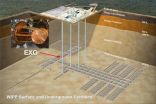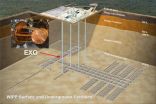(Press-News.org) CAMBRIDGE, Mass. -- Police and security teams guarding airports, docks and border crossings from terrorist attack or illegal entry need to know immediately when someone enters a prohibited area, and who they are. A network of surveillance cameras is typically used to monitor these at-risk locations 24 hours a day, but these can generate too many images for human eyes to analyze.
Now, a system being developed by Christopher Amato, a postdoc at MIT's Computer Science and Artificial Intelligence Laboratory (CSAIL), can perform this analysis more accurately and in a fraction of the time it would take a human camera operator. "You can't have a person staring at every single screen, and even if you did the person might not know exactly what to look for," Amato says. "For example, a person is not going to be very good at searching through pages and pages of faces to try to match [an intruder] with a known criminal or terrorist."
Existing computer-vision systems designed to carry out this task automatically tend to be fairly slow, Amato says. "Sometimes it's important to come up with an alarm immediately, even if you are not yet positive exactly what it is happening," he says. "If something bad is going on, you want to know about it as soon as possible."
So Amato and his University of Minnesota colleagues Komal Kapoor, Nisheeth Srivastava and Paul Schrater are developing a system that uses mathematics to reach a compromise between accuracy — so the system does not trigger an alarm every time a cat walks in front of the camera, for example — with the speed needed to allow security staff to act on an intrusion as quickly as possible.
For camera-based surveillance systems, operators typically have a range of computer-vision algorithms they could use to analyze the video feed. These include skin detection algorithms that can identify a person in an image, or background detection systems that detect unusual objects, or when something is moving through the scene.
To decide which of these algorithms to use in a given situation, Amato's system first carries out a learning phase, in which it assesses how each piece of software works in the type of setting in which it is being applied, such as an airport. To do this, it runs each of the algorithms on the scene, to determine how long it takes to perform an analysis, and how certain it is of the answer it comes up with. It then adds this information to its mathematical framework, known as a partially observable Markov decision process (POMDP).
Then, for any given situation — if it wants to know if an intruder has entered the scene, for example — the system can decide which of the available algorithms to run on the image, and in which sequence, to give it the most information in the least amount of time. "We plug all of the things we have learned into the POMDP framework, and it comes up with a policy that might tell you to start out with a skin analysis, for example, and then depending what you find out you might run an analysis to try to figure out who the person is, or use a tracking system to figure out where they are [in each frame]," Amato says. "And you continue doing this until the framework tells you to stop, essentially, when it is confident enough in its analysis to say there is a known terrorist here, for example, or that nothing is going on at all."
Like a human detective, the system can also take context into account when analyzing a set of images, Amato says. So for instance, if the system is being used at an airport, it could be programmed to identify and track particular people of interest, and to recognize objects that are strange or in unusual locations, he says. It could also be programmed to sound an alarm whenever there are any objects or people in the scene, when there are too many objects, or if the objects are moving in ways that give cause for concern.
In addition to port and airport security, the system could monitor video information obtained by a fleet of unmanned aircraft, Amato says. It could also be used to analyze data from weather-monitoring sensors to determine where tornados are likely to appear, or information from water samples taken by autonomous underwater vehicles, he says. The system would determine how to obtain the information it needs in the least amount of time and with the fewest possible sensors.
###Amato and his colleagues will present their system in a paper at the 24th IAAI Conference on Artificial Intelligence in Toronto in July.
Written by Helen Knight, MIT News Office
System improves automated monitoring of security cameras
New approach uses mathematics to reach a compromise between accuracy and speed
2012-06-05
ELSE PRESS RELEASES FROM THIS DATE:
Giant black hole kicked out of home galaxy
2012-06-05
Astronomers have found strong evidence that a massive black hole is being ejected from its host galaxy at a speed of several million miles per hour. New observations from NASA's Chandra X-ray Observatory suggest that the black hole collided and merged with another black hole and received a powerful recoil kick from gravitational wave radiation.
"It's hard to believe that a supermassive black hole weighing millions of times the mass of the sun could be moved at all, let alone kicked out of a galaxy at enormous speed," said Francesca Civano of the Harvard-Smithsonian Center ...
High blood caffeine levels in older adults linked to avoidance of Alzheimer's disease
2012-06-05
Tampa, FL (June 4, 2012) Those cups of coffee that you drink every day to keep alert appear to have an extra perk – especially if you're an older adult. A recent study monitoring the memory and thinking processes of people older than 65 found that all those with higher blood caffeine levels avoided the onset of Alzheimer's disease in the two-to-four years of study follow-up. Moreover, coffee appeared to be the major or only source of caffeine for these individuals.
Researchers from the University of South Florida (www.usf.edu) and the University of Miami (www.miami.edu)say ...
JEBDP looks at connections between preventive dentistry and public health
2012-06-05
St. Louis, MO, June 4, 2012 – The dental profession needs to build a stronger connection between oral health and general health—not only for individual patients, but also at the community level, according to the special June issue of The Journal of Evidence-Based Dental Practice (JEBDP), the foremost publication of information about evidence-based dental practice, published by Elsevier.
The special issue follows the usual format of JEBDP, comprising expert reviews and analyses of the scientific evidence on specific dental procedures. "Yet the coverage goes beyond a review ...
BUSM researcher finds link between brain signaling and renal function
2012-06-05
(Boston) - Boston University School of Medicine (BUSM) researchers recently uncovered a brain signaling pathway responsible for regulating the renal excretion of sodium. The findings appear in the Journal of the Federation of American Societies for Experimental Biology.
Hypertension, or chronic high blood pressure, affects one-third of adults, significantly increasing cardiovascular risk and mortality. Approximately 50 percent of hypertensive patients are salt-sensitive and exhibit an increase in blood pressure following salt-intake.
According to the researchers, little ...
New immune therapy shows promise in kidney cancer
2012-06-05
BOSTON – An antibody that helps a person's own immune system battle cancer cells shows increasing promise in reducing tumors in patients with advanced kidney cancer, according to researchers at Beth Israel Deaconess Medical Center.
The results of an expanded Phase 1 trial presented at the American Society of Clinical Oncology's annual conference in Chicago, showed that some patients treated with a fully human monoclonal antibody developed by Bristol Myers Squibb had a positive response to the effort by the agent, BMS-936558, to prolong the immune system's efforts to fight ...
Underground search for neutrino properties unveils first results
2012-06-05
Menlo Park, Calif. — Scientists studying neutrinos have found with the highest degree of sensitivity yet that these mysterious particles behave like other elementary particles at the quantum level. The results shed light on the mass and other properties of the neutrino and prove the effectiveness of a new instrument that will yield even greater discoveries in this area.
The Enriched Xenon Observatory 200 (EXO-200), an international collaboration led by Stanford University and the U.S. Department of Energy's (DOE) SLAC National Accelerator Laboratory, has begun one of ...
Vaccinations of US children declined after publication of now-refuted autism risk
2012-06-05
New University of Cincinnati research has found that fewer parents in the United States vaccinated their children in the wake of concerns about a purported link (now widely discredited) between the MMR (measles, mumps, rubella) vaccine and autism.
Lenisa Chang, assistant professor of economics in UC's Carl H. Lindner College of Business, found that the MMR-autism controversy, which played out prominently in the popular media following publication in a 1998 medical journal, led to a decline of about two percentage points in terms of parents obtaining the MMR vaccine for ...
Physicists close in on a rare particle-decay process
2012-06-05
PASADENA, Calif.—In the biggest result of its kind in more than ten years, physicists have made the most sensitive measurements yet in a decades-long hunt for a hypothetical and rare process involving the radioactive decay of atomic nuclei.
If discovered, the researchers say, this process could have profound implications for how scientists understand the fundamental laws of physics and help solve some of the universe's biggest mysteries—including why there is more matter than antimatter and, therefore, why regular matter like planets, stars, and humans exists at all. ...
Emergency department algorithm may predict risk of death for heart failure patients
2012-06-05
Physicians can reduce the number of heart failure deaths and unnecessary hospital admissions by using a new computer-based algorithm developed at the Institute for Clinical Evaluative Sciences (ICES) that calculates each patient's individual risk of death. Published in the Annals of Internal Medicine, the algorithm improves upon clinical decision-making and determines whether or not a patient with heart failure should be admitted to hospital. To bring this tool into the emergency departments, Peter Munk Cardiac Centre cardiologists are developing smartphone and web-based ...
June 2012 story tips from Oak Ridge National Laboratory
2012-06-05
MATERIALS – Transparent performance . . .
Windshields, windows, solar panels, eyeglasses, heart stents and hundreds of other products representing a multi-billion-dollar market are potential targets for Oak Ridge National Laboratory's thin-film superhydrophobic technology. Conventional commercially available products tend to lack transparency, suitable bonding capability or both, making them largely impractical, said Tolga Aytug, one of the developers. The ORNL product, based on glass, can be produced with manufacturing processes that are cost effective and easily scaled ...
LAST 30 PRESS RELEASES:
Researchers observe gas outflow driven by a jet from an active galactic nucleus
Pitt student finds familiar structure just 2 billion years after the Big Bang
Evidence of cross-regional marine plastic pollution in green sea turtles
Patients with clonal hematopoiesis have increased heart disease risk following cancer treatment
Stem cell therapy for stroke shows how cells find their way in the brain
Environment: Up to 4,700 tonnes of litter flows down the Rhine each year
Maternal vaccine receipt and infant hospital and emergency visits for influenza and pertussis
Interim safety of RSVpreF vaccination during pregnancy
Stem cell engineering breakthrough paves way for next-generation living drugs
California grants $7.4 million to advance gene-edited stem cell therapy for Friedreich’s ataxia
Victoria’s Secret grant backs cutting-edge ovarian cancer research
Research paves the way for safer colonoscopy bowel prep for people with compromised gut health
JMIR Publications and Sweden's National Library announce renewal and expansion of flat-fee unlimited open access partnership for 2026
A new 3D-printed solar cell that’s transparent and color-tunable
IV iron is the cost-effective treatment for women with iron deficiency anemia and heavy menstrual bleeding
Doing good pays off: Environmentally and socially responsible companies drive value and market efficiency
City of Hope and Cellares to automate manufacturing of solid tumor CAR T cell therapy
Short-circuiting pancreatic cancer
Groundbreaking mapping: how many ghost particles all the Milky Way’s stars send towards Earth
JBNU researchers propose hierarchical porous copper nanosheet-based triboelectric nanogenerators
A high-protein diet can defeat cholera infection
A more accurate way of calculating the value of a healthy year of life
What causes some people’s gut microbes to produce high alcohol levels?
Global study reveals widespread burning of plastic for heating and cooking
MIT study shows pills that communicate from the stomach could improve medication adherence
Searching for the centromere: diversity in pathways key for cell division
Behind nature’s blueprints
Researchers search for why some people’s gut microbes produce high alcohol levels
Researchers find promising new way to boost the immune response to cancer
Coffee as a staining agent substitute in electron microscopy
[Press-News.org] System improves automated monitoring of security camerasNew approach uses mathematics to reach a compromise between accuracy and speed



